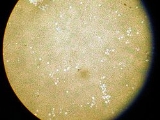
Azomonas
Encyclopedia
Azomonas are typically motile, oval to spherical, and secrete large quantities of capsular slime
. They are distinguished from Azotobacter
by their inability to form cysts, but like Azotobacter they can biologically fix nitrogen under aerobic conditions (diazotroph
).
Members of the genus Azomonas can be referred to as azomonads (viz. Trivialisation of names).
Slime layer
A slime layer in bacteria is an easily removed, diffuse, unorganized layer of extracellular material that surrounds bacteria cells. Specifically, this consists mostly of exopolysaccharides, glycoproteins, and glycolipids....
. They are distinguished from Azotobacter
Azotobacter
Azotobacter is a genus of usually motile, oval or spherical bacteria that form thick-walled cysts and may produce large quantities of capsular slime. They are aerobic, free-living soil microbes which play an important role in the nitrogen cycle in nature, binding atmospheric nitrogen, which is...
by their inability to form cysts, but like Azotobacter they can biologically fix nitrogen under aerobic conditions (diazotroph
Diazotroph
Diazotrophs are bacteria and archaea that fix atmospheric nitrogen gas into a more usable form such as ammonia.A diazotroph is an organism that is able to grow without external sources of fixed nitrogen. Examples of organisms that do this are rhizobia and Frankia and Azospirillum. All diazotrophs...
).
Etymology
The name Azomonas derives from:- New LatinNew LatinThe term New Latin, or Neo-Latin, is used to describe the Latin language used in original works created between c. 1500 and c. 1900. Among other uses, Latin during this period was employed in scholarly and scientific publications...
noun azotum [from Fr. noun azote (from Greek prep. a, not; Greek noun zōē, life; N.Greek noun azōē, not sustaining life)], nitrogen; New LatinNew LatinThe term New Latin, or Neo-Latin, is used to describe the Latin language used in original works created between c. 1500 and c. 1900. Among other uses, Latin during this period was employed in scholarly and scientific publications...
pref. azo-, pertaining to nitrogen; LatinLatinLatin is an Italic language originally spoken in Latium and Ancient Rome. It, along with most European languages, is a descendant of the ancient Proto-Indo-European language. Although it is considered a dead language, a number of scholars and members of the Christian clergy speak it fluently, and...
feminine genderGrammatical genderGrammatical gender is defined linguistically as a system of classes of nouns which trigger specific types of inflections in associated words, such as adjectives, verbs and others. For a system of noun classes to be a gender system, every noun must belong to one of the classes and there should be...
noun monas (μονάς / μονάδα)-monasThe suffix -monas is used in microbiology for many genera and is intended to mean "unicellular organism".-Meaning:The suffix -monas is used in microbiology for many genera in a similar way to -bacter, -bacillus, -coccus or -spirillum...
, nominally meaning "a unit", but in effect meaning a bacterium; New LatinNew LatinThe term New Latin, or Neo-Latin, is used to describe the Latin language used in original works created between c. 1500 and c. 1900. Among other uses, Latin during this period was employed in scholarly and scientific publications...
feminine genderGrammatical genderGrammatical gender is defined linguistically as a system of classes of nouns which trigger specific types of inflections in associated words, such as adjectives, verbs and others. For a system of noun classes to be a gender system, every noun must belong to one of the classes and there should be...
noun Azomonas, nitrogen monad.
Members of the genus Azomonas can be referred to as azomonads (viz. Trivialisation of names).

